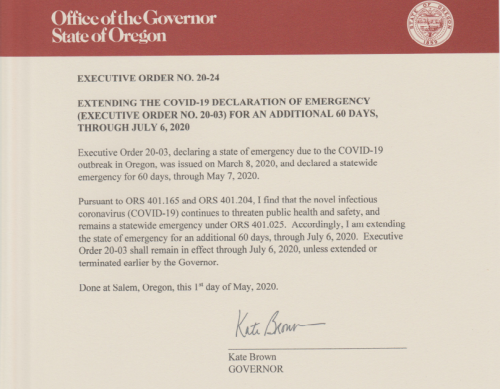
The day before maskless protesters took to the Oregon state Capitol to rally against stay-at-home orders, Gov. Kate Brown extended her state of emergency declaration for another 60 days. The governor signed the executive order on May 1. The state of emergency could end July 6 or earlier if she wants. Of course, Brown could also extend it — as she just did.
The state of emergency (formally known as Executive Order 20-24) is not the same as the stay at home order. According to an email from the governor’s office, Brown’s state of emergency is the “legal underpinning” of the executive orders she issued to flatten the COVID-19 curve.
Those orders include the Stay Home, Save Lives order, which directed people to stay at home, maintain a six-foot distance when outside their homes, as well as essentially closed businesses like barbershops, theaters, gyms and more.
The state of emergency also allows Brown to make executive orders to tackle economic impacts related to COVID-19 social distancing, such as a moratorium on residential and commercial evictions. Those orders stay in effect by extending the declaration.
However, Brown can lift orders when needed, as she did with delaying non-essential medical procedures, the governor’s office says.
The governor’s office says moving forward with reopening the state “will be incremental, and based on science and data. Executive Order 20-24 allows that process of reopening Oregon safely and carefully to continue.”
Although Oregon’s response to COVID-19 has generated some criticism of the governor, it has allowed certain businesses to operate that California and Washington haven’t. Brown said at her May 1 press conference that Washington state Gov. Jay Inslee has expressed frustration over stopping construction sites, which Oregon allowed to continue. And today California Gov. Gavin Newsom announced some retail businesses could start opening soon if they offer curbside delivery.
At Brown’s May 1 press conference, Brown reminded Oregon that the road to reopening the state is going to be longer than we’d like and that social distancing measures won’t be terminated until there is a treatment or vaccine for COVID-19.